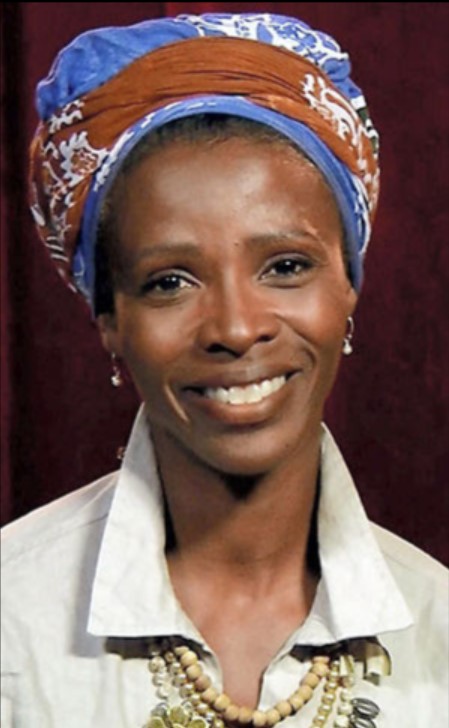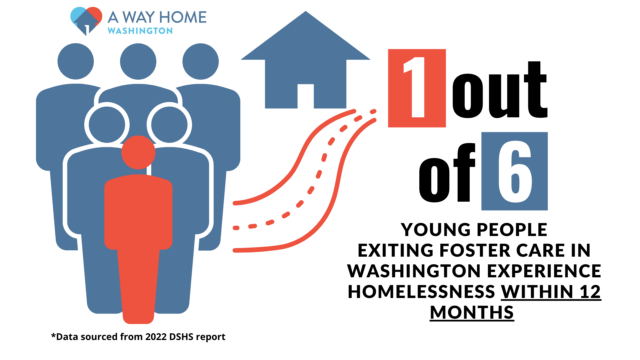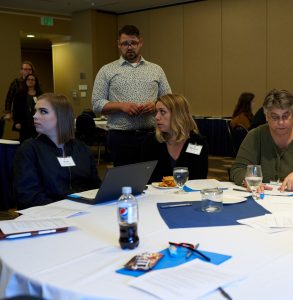New Report Demonstrates Effectiveness of Flexible Diversion Funds for Young People At Risk of Homelessness
‘30 in 30’ challenge leads to 86 young people in Pierce, Spokane, Yakima, and Walla Walla counties prevented from entering the homelessness system or diverted out last month
WASHINGTON – A Way Home Washington (AWHWA), the campaign to prevent and end youth and young adult homelessness in Washington state, released an eye-opening new report explaining and demonstrating achievements of the Centralized Diversion Fund (CDF) pilot, a program that provides flexible payments made to prevent young people from experiencing homelessness or divert young people from homelessness within 30 days.
The report – The A Way Home Washington Centralized Diversion Fund: Using Flexible Funds to Prevent and End Youth and Young Adult Homelessness in Washington State – was prepared for the Schultz Family Foundation, which serves as a key funder of the CDF along with the state Office of Homeless Youth. The report outlines the successes of the pilot program since its launch in August 2020 in Pierce, Spokane, Yakima, and Walla Walla counties. At press time in late May, the CDF had resulted in more than 220 young people finding a housing solution. 96% of people who exited homelessness did not return within three months. More than half were young people of color.
“Ending youth homelessness is not just about helping someone exit homelessness, it requires reaching a young person before they ever enter the homelessness system,” said Julie Patiño, Executive Director of A Way Home Washington. “By spending a relatively small amount of money now, we are able to creatively remove small barriers and end a young person’s housing crisis. In doing so, you save an incredible amount of time and resources later on – but most importantly, you might be saving someone’s life. The Centralized Diversion Fund is also an important tool to ensure young people of color and LGBTQ youth can access the unique housing resources that they need to move out of the homelessness system.”
A diversion fund is a flexible pool of money that can be drawn upon by youth workers in consultation with their clients – in this case, young people experiencing housing instability and at risk of not having a place to live. With the CDF, anyone who works with young people can be trained to administer diversion services, coupled with help for anything that might execute a housing plan, such as acquiring a state-issued identification card, filling out job applications, and applying for student financial aid. The CDF can be used for anything that will result in a young person being housed outside of the homelessness system. Examples include paying for child care so that a young parent can go to work and stabilize their housing situation, paying for a rental security deposit so that a young person can move into a new home, or countless other creative solutions.
From May 20 to June 20, AWHWA worked with the four Anchor Communities – Pierce, Spokane, Yakima, and Walla Walla counties – to create an additional proof-of-concept for the CDF by launching the “30 Diversions In 30 Days” campaign. ‘30 In 30’ challenged each community to divert 30 young people out of homelessness during the 30 day period, using CDF funds and innovative housing solutions. In total, the communities broke expectations and served 86 young people over the 30 day stretch.
Elisha P., a Homeless Youth and Young Adult Services Navigator for Blue Mountain Action Council in Walla Walla, personally housed 19 people from May 20 to June 20. Elisha said, “As someone with my own experience of housing instability and young adult homelessness, I know that diversion is such a powerful tool beyond monetary measure. The real value is in the conversation that helps build a stronger connection between the young person and me. Connection and trust lends itself to some pretty amazing solutions. I can really lean in and create a space for the young person to share with me who they are and where they want to be. With that knowledge, I can sit in the passenger seat and help them find their own resolution. Diversion funding is what allows me to say “Yes!” when they identify a housing solution and make their creative idea a reality.”
AWHWA’s Anchor Community Initiative (ACI) that created the Centralized Diversion Fund is in the midst of a multi-year effort to functionally end youth and young adult homelessness in the four communities mentioned above – achieving “yes to yes,” where communities are able to stably house every young person experiencing homelessness quickly. Thanks to leadership from Governor Jay Inslee, AWHWA Co-Chair First Lady Trudi Inslee, and legislative leaders, state funding for the ACI was renewed this year for another budget biennium. At the same time, the state’s final budget includes funding to expand the ACI into new communities across the state. AWHWA will make announcements later this year about the future of ACI expansion, along with likely expansion of the CDF.
For more information (non press inquiries) about the Anchor Community Initiative and Centralized Diversion Fund, reach out to Ashley Barnes-Cocke at abarnes-cocke@awayhomewa.org.
 Since October of 2023, A Way Home Washington (AWHWA) Strategic Communications Director, Ben Sung Henry, has served as Interim Executive Director during Julie Patiño’s continuing leave. Thanks to the leadership of Ben and many others, AWHWA is now in a place to continue moving forward in our mission to reduce and ultimately end unaccompanied youth and young adult homelessness in Washington.
Since October of 2023, A Way Home Washington (AWHWA) Strategic Communications Director, Ben Sung Henry, has served as Interim Executive Director during Julie Patiño’s continuing leave. Thanks to the leadership of Ben and many others, AWHWA is now in a place to continue moving forward in our mission to reduce and ultimately end unaccompanied youth and young adult homelessness in Washington.

 A Way Home Washington’s (AWHWA’s) Centralized Diversion Fund (CDF) is a cost-effective, young person-centered solution to homelessness and housing instability that is already transforming the four Anchor Communities. Since its launch last August at the height of the pandemic, Yakima, Pierce, Spokane and Walla Walla counties have collectively housed more than 220 youth and young adult (YYA) households.
A Way Home Washington’s (AWHWA’s) Centralized Diversion Fund (CDF) is a cost-effective, young person-centered solution to homelessness and housing instability that is already transforming the four Anchor Communities. Since its launch last August at the height of the pandemic, Yakima, Pierce, Spokane and Walla Walla counties have collectively housed more than 220 youth and young adult (YYA) households.